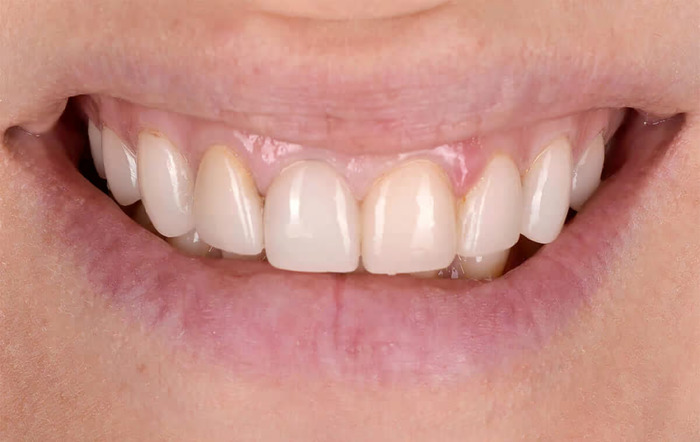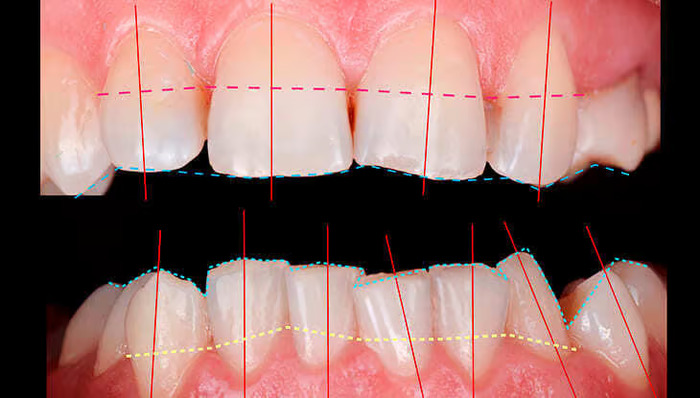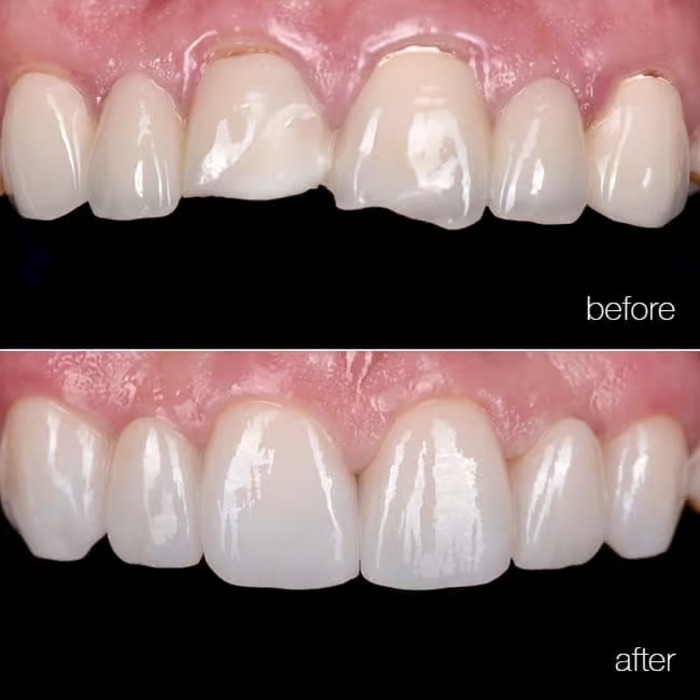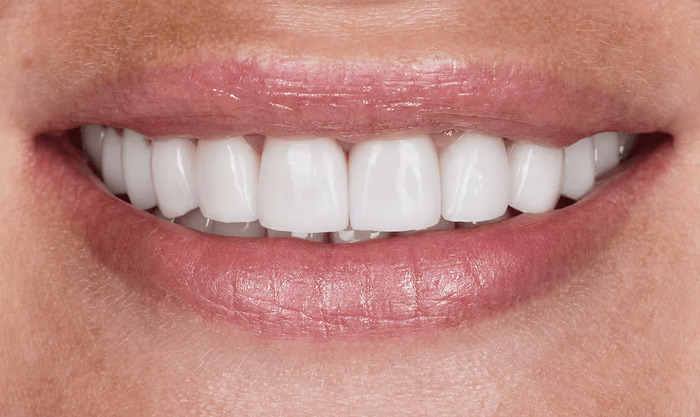Gummy Smile and Ways to Fix It

Contents:
In 15% of people, when smiling, not only the upper teeth but also a significant portion of the gum line are fully visible. This is called a gingival smile or gummy smile. In dentistry, this situation is not considered a pathology because it usually does not affect the health of the teeth and surrounding tissues.
Some people perceive it as their peculiarity while smiling with gums causes complexes and discomfort when socialising with others. Today, you will learn how to solve this problem effectively at the Clinic of Aesthetic Dentistry in Kyiv.

What Is a Gummy Smile?
Medically speaking, a gingival smile refers to cases with more than 2 mm of visible gum line above the upper teeth. Most often, people complain about a cosmetic defect. They are embarrassed by their peculiarity and try not to smile when talking and in photos.
In this case, public figures who are always in the public eye and representatives of professions involving constant communication are in the most challenging position.
If anomalies of gum development or malocclusion accompany a gummy smile, it becomes a medical problem. Patients may experience bleeding and inflammation of the gums, increased risk of periodontitis and loosening of teeth.
Causes of Gummy Smile in Adults and Children
The following factors contribute to excessive gum exposure:
- overdevelopment of the upper jaw bone, causing the upper lip to be relatively short and unable to cover the gum tissues fully;
- a bad bite, pushing forward the upper incisors;
- pathological abrasion and reduced height of the upper row of teeth;
- overdevelopment of the mucous membrane, with the gums covering a large area of the crowns of the front teeth;
- hypertension of the oral circular muscle, which causes the lip to rise higher than usual;
- an underdeveloped and short upper lip.
Since many cases of gingival smile are related to anatomical features, it is not uncommon for the gummy smile to appear as early as childhood after a bite change and remain for life. However, the situation can also arise for the first time in adulthood – with changes in muscle tone, dental problems, and age-related changes.
Gummy Smile Diagnosis
A dentist can identify a gingival smile during an examination. At the consultation, the dental specialist takes photos from different angles to fix the initial case. Additional methods of assessment are prescribed to choose the method of treatment. To assess the state of the dentoalveolar system, the dentist conducts a panoramic image of the teeth and a CT scan of the jaw. The patient will have to take standard analyses before invasive manipulations and surgeries.

Gingival Smile Correction Options
Modern medicine has different approaches to removing the gingival smile, from quick and minimally invasive cosmetology methods to dental surgeries.
They are mainly performed for aesthetic reasons if a person is dissatisfied with the appearance and wants to change the peculiarity that bothers them. People who performed aesthetic dental restoration in Kyiv or other aesthetic dentistry procedures often need this procedure. Such patients’ tooth rows look fine, but the overall impression does not correspond to the desired one because the gum line is very noticeable when smiling.
Orthodontic Treatment
Correction for medical reasons is only carried out in cases of bite anomalies and other dental problems. In this case, doctors’ primary efforts aim to restore the correct position and shape of the teeth, after which the cosmetic defect also disappears.
Bite Correction
Dental specialists use braces or aligners to put the teeth in the correct position. The duration and specifics of treatment depend on the extent of the defect, size of the jawbone, age of the patient and other factors. Complex anomalies may require orthodontic surgery.
Upon completion of treatment, the patient receives an even tooth row. At the same time, the front teeth do not protrude forward, so the visibility of the gums when smiling is reduced.
Placement of Veneers
Ceramic onlays improve the overall aesthetics of the tooth row and correct the shape of the front incisors to hide a gingival smile. Veneers are an independent correction method for minor signs of a gummy smile. In most cases, they are combined with orthodontic or surgical procedures.

Surgery
Dental surgery can radically solve the problem of a gummy smile. This method is recommended for patients diagnosed with mucosal hyperplasia or jaw anomalies.
Gingivoplasty
The standard of treatment is recognised as gingivectomy – removal of excess gingival tissue. During the surgery, the surgeon carefully removes the excess soft tissue. The procedure improves the aesthetics of the tooth row and allows you to get rid of the gingival smile once and for all.
In modern dentistry, such treatment is carried out with the help of a laser. Laser surgery is a sutureless and minimally traumatic method of surgery. The rehabilitation period is only 7 days.
Plastic Surgery of the Frenum of the Upper Lip
The frenulum is a fold of mucous membrane in the oral cavity. It is located in the middle of the upper lip and helps attach the jawbone. When the frenulum is shortened, the lip is too much raised upwards, which causes discomfort and interferes with chewing and smiling.
A quick and uncomplicated operation is indicated to correct the anomaly. It takes a few minutes and is performed under local anaesthesia. After cutting the frenulum, the upper lip takes an anatomically correct position and covers the gums when smiling.
Reconstructive Plastic Surgery
Maxillofacial plastic surgery is prescribed in case of original or trauma-induced bone deformities. The technique is used in complex cases if other surgical manipulations do not allow you to correct the defect. During reconstructive plastic surgery, the doctor forms the correct line of the jawbone and corrects bite anomalies.

Cosmetic Procedures – Alternative Methods of Correcting Gummy Smile
Covering the gums when smiling depends not only on the position of the teeth and jawbone but also on the size of the upper lip. If orthodontic treatment is not required and the patient does not want surgery, you can try cosmetic dentistry. Minor invasive injection techniques give instant results. They have a minimum of contraindications and do not require complex rehabilitation. However, the effect of procedures is short-term – on average, about 6 months, so they will have to be repeated often.
Treating Gummy Smile with Botox
Botulinum therapy is used for muscle hypertonus. After injecting the drug, the mimic muscles relax, so the upper lip becomes less mobile. Botox also smooths wrinkles around the mouth and prevents new creases from forming.
Enhancing Lip Volume
After contour correction, the upper lip becomes larger and covers the gums well when smiling. The procedure uses dense and viscous gels with hyaluronic acid, a natural component of the intercellular substance in the skin. The product adds the desired volume and helps to correct lip asymmetry, if present.

Contraindications in Gummy Smile Correction
Scheduled surgeries for gummy smile correction are not prescribed in the following situations:
- exacerbation of diseases of internal organs;
- acute infectious diseases, fever;
- inflammatory or purulent processes in the area of manipulation;
- blood clotting disorders;
- severe immunodeficiency conditions.
Dental diseases: tooth decay, gingivitis, periodontitis, and stomatitis are temporary limitations to correcting the gingival smile. First, oral cavity treatment and dental prophylaxis are necessary, and then aesthetic operations are performed.
How To Choose Treatment to Correct Gummy Smile?
The optimal method of gummy smile correction depends on
- the cause of the defect;
- the degree of its severity;
- the presence of bite anomalies;
- abnormalities in the jawbone structure.
In some cases, a visit to a beauty expert or a single gingivoplasty is sufficient, while in other cases, a long-term and complex treatment will be required. The patient’s wishes, lifestyle, requirements for the smile’s aesthetics, and financial possibilities are considered when selecting the treatment.
The first step to successfully correcting a gingival smile is a visit to a dentist at the KES clinic. At the consultation, the doctor will assess the condition of the dental-mandibular system, prescribe the required examination and analyse the results. An orthodontist, orthopaedic dentist, gnathologist, or maxillofacial surgeon may be involved in the treatment.
New computer technologies and 3D reconstruction methods are used to develop a correction plan. The dental clinic performs orthodontic and surgical manipulations that allow you to form a perfect smile.

